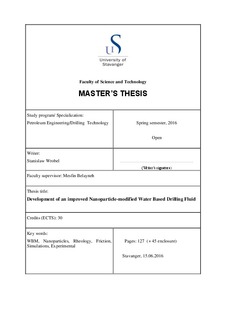| dc.contributor.advisor | Belayneh, Mesfin | |
| dc.contributor.author | Stanislaw, Wrobel | |
| dc.date.accessioned | 2016-09-21T08:13:48Z | |
| dc.date.available | 2016-09-21T08:13:48Z | |
| dc.date.issued | 2016-06 | |
| dc.identifier.uri | http://hdl.handle.net/11250/2409072 | |
| dc.description | Master's thesis in Petroleum engineering | nb_NO |
| dc.description.abstract | The objective was to improve conventional water based drilling fluid systems by the addition of nanoparticles. Experiments were conducted to evaluate whether addition of nanoparticles to the drilling fluid could improve rheological, lubricating, viscoelastic and filtrate loss properties. The rheological properties were measured using av Fanning-VG viscometer. The lubricating properties of the fluid were determined through friction coefficient measurements using a CSM DIN 50324 Tribometer at varying temperatures, while filtrate loss was measured using standard API filtrate loss test setup. The tested nanoparticle additives were MoS2, Graphene, TiO2 and TiN. The results show that nanoparticle additives to the drilling fluid can improve the rheological properties. Addition of 0.1 g MoS2 per 500 ml at ambient temperature, improved the Bingham Yield Strength (YS) of the drilling fluid by 183 % relative to the reference fluid. Similar experiments with higher concentration in the range of 0.2 g to 0.4 g per 500 mL, showed that increasing the nanoparticle concentration leads to a reduction in Bingham YS at ambient temperature. The same added concentrations showed that Graphene, TiO2 and TiN did not have a significant impact on the fluid rheological properties. Nanoparticle composition and size may therefore impact the potential for drilling property improvement. In terms of lubricating properties, the experiments show that nanoparticles can improve the lubricity of the drilling fluid by reducing the friction coefficient. MoS2 showed a reduction in friction coefficient of up to 53 %, while Graphene modified fluid systems showed up to 56 % reduction. TiO2 and TiN did not show lubricating effects, in some cases increasing the friction coefficient of the drilling fluid. Experiments at temperatures ranging from 20-70 °C showed that MoS2 and Graphene yield improved lubricity at all tested temperatures. Based on experimental results Hydraulic, Cuttings transport and Torque & Drag simulations were conducted. Simulations suggested that 0.4g MoS2 added to the drilling fluid could reduce the bed height by 45%, improving cuttings transport capacity significantly. Torque & drag simulations suggest that the improved lubricity of graphene and MoS2 addition could extend drilling reach by as much as 26.3%. | nb_NO |
| dc.language.iso | eng | nb_NO |
| dc.publisher | University of Stavanger, Norway | nb_NO |
| dc.relation.ispartofseries | Masteroppgave/UIS-TN-IPT/2016; | |
| dc.subject | petroleumsteknologi | nb_NO |
| dc.subject | petroleum engineering | nb_NO |
| dc.subject | drilling | nb_NO |
| dc.subject | nanoparticles | nb_NO |
| dc.subject | boreteknologi | nb_NO |
| dc.subject | friction | nb_NO |
| dc.title | Development of an improved Nanoparticle-modified Water Based Drilling Fluid | nb_NO |
| dc.type | Master thesis | nb_NO |
| dc.subject.nsi | VDP::Technology: 500::Rock and petroleum disciplines: 510::Petroleum engineering: 512 | nb_NO |
| dc.source.pagenumber | 170 | nb_NO |
